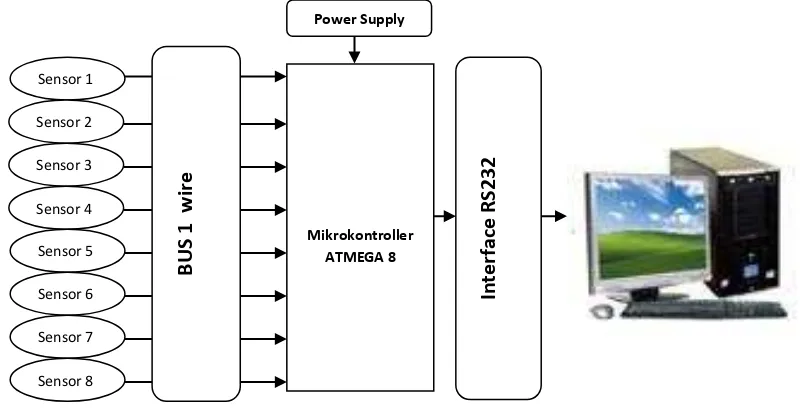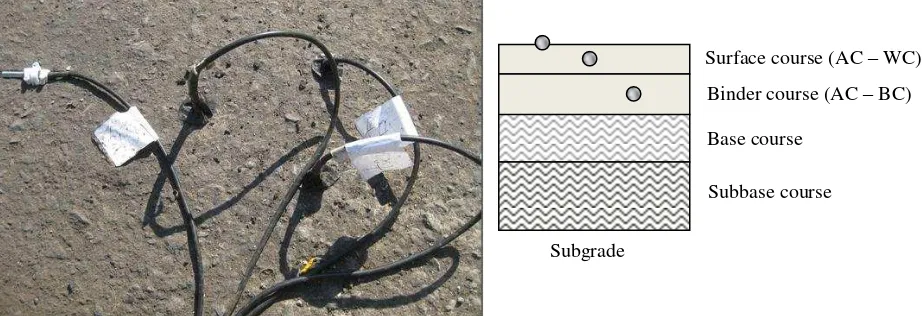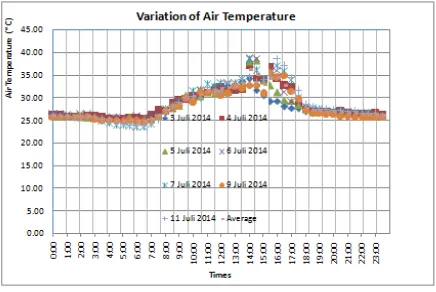Asphalt Pavement Temperature Profile for Tropical Climate in Indonesia
I Made Agus Ariawan1,a, Bambang Sugeng Subagio2,b and Bagus Hario Setiadji3,c
1Udayana University, Indonesia
Doctoral Student Diponegoro University, Indonesia
2Bandung Institute of Technology, Indonesia 3Diponegoro University, Indonesia
a[email protected], b[email protected], c[email protected]
Abstract. Environmental and climatic factors directly affect the temperature of asphalt pavement layers. Air temperature is one of the most important environmental factors that significantly affect the temperature distribution profile of asphalt pavement layers. It is important therefore, to comprehend the asphalt strength characteristics because of the differences in asphalt pavement designs. This study was conducted in the tropical area with high humidity in Indonesia. A testing method is carried out to measure both temperature and humidity using thermocouples equipped with data logger and an application program of SAGA Technology. Measurements were taken for consecutive seven sunny days in July 2014. The average values obtained for hourly air temperature and humidity were ranging from 24.92 to 36.98 0C and from 50.31 to 83.69% respectively. Meanwhile, pavement surface temperatures measured at 0, 20 and 65 millimeters depths were varied from 25.29 to 45.65 0C, from 25.37 to 43.59 0C, and from 26.70 to 38.54 0C respectively.
Both air and asphalt pavement temperatures are sharply increased from 10:00 a.m. to 02:00 p.m. and are gradually decreased afterward.
Keywords: air temperature, relative humidity, asphalt pavement temperature
Introduction
The asphalt pavement layers temperatures vary because of several factors consisting air temperature, solar radiation, wind speed, and pavement surface reflectance. Air temperature is one of the most important environmental factors for which influencing the mechanical properties of asphalt mixtures [3]. Meanwhile, air temperature variation directly affects asphalt pavement layer temperature. In addition, temperature distribution on the cross section of asphalt pavement layer is importantly considered because of the strength characteristics of various asphalt pavement designs.
Literature Review
Asphalt pavement temperature profile is directly influenced by environmental factors described in energy balance concept as shown in Figure 1. These factors generally include climatic conditions consisting air temperature and humidity, wind speed, solar radiation, evaporation, radiation wavelength, back radiation and heat absorption on asphalt pavement. The differences on latitudes brought each region has different climates i.e. tropical, sub-tropical, temperate and cold climates as shown in Figure 2.
Fig. 1, Energy balance on the pavement surface [3]
Fig. 2, Climate types based on different latitudes
The pavement temperature distribution is importantly considered in relation to asphalt performance classification and structural capacity determination. In recent years, researches on this topic however, are still widely developed in many countries with different climates including in the United States, Oman, China, Serbia, Portugal, Spain, Iran dan Lithuania [1, 2, 3, 4, 5, 6, 7, 8, 9].
Cold climate
Temperate climate Climate
Sub tropical climate Climate
Methods
The data for this study were obtained by measuring air temperature and humidity and asphalt pavement temperature using thermocouples with a data logger. Temperatures measurement system is shown in Figure 3. Meanwhile, the equipment used in this study is described as follows:
1. A type of DS18B20 is used for sensors and signal conditioning. This is a digital temperature sensor with a resolution between 9 and 12 Bit ± 0.5 0C. In addition, it can be used to
measure a temperature between 55 and 125 0C. This sensor has a data communication system using a BUS 1 wire lane.
2. A microcontroller of ATMEGA 8 is used for signal processing. This part serves as signal processing and data communication control between sensors and computer.
3. An interface is a part of data logger which connecting between the microcontroller and a
computer in a serial data format.
4. A computer monitor is used to display data measurement result using a customized application program.
5. A data recorder is used to record the measured data. In this study, a customized application program is developed using a visual basic programming language.
Fig. 3, Temperature measurement system
Asphalt Pavement Monitoring Station
The primary data were collected on a national road of Jl. Mahendradatta in Denpasar Bali-Indonesia. An observation station has been installed to collect data consisting air temperature and humidity and pavement temperature at various depths. In order to minimize the influence of other climatic factors on pavement humidity, the measurement was conducted on sunny days in a dry season and during maximum air temperature periods.
Fig. 4, Pavement layers and thermocouple sensor positions for pavement temperature observation
Fig. 5, Sensor position for air and humidity temperature measurements
A measurement sensor is connected to the signal processor using a microcontroller of ATMega 8 as shown in Figure 6. This is used to be the signal processing and data communications controller between sensors. In a serial data format, an interface connects the microcontroller with a computer to display and record the measured data through a customized application program developed by SAGA Technology as shown in Figure 7.
Fig. 6, A Microcontroller of ATMega 8 Fig. 7, Data Recorder with a customized application program of SAGA Technology
Surface course (AC – WC) Binder course (AC – BC)
Base course
Subbase course
Subgrade
Air temperature and humidity sensor position
Road pavement
Results and Discussion
Air temperature and humidity data were collected for consecutive seven days on sunny weathers in July 2014. Both hourly average variations are shown in Figures 8 and 9. Figure 8 shows that air temperature commenced to increase at 6:00 a.m. and reached a maximum value of 36.28 0C at 02:00 p.m. Subsequently, the temperature gradually decreased and reached the minimum value of 24.92
0C at 05:00 a.m. Meanwhile, Figure 9 describes that air humidity began to increase at 05:00 a.m.
and got to the maximum value of 83.69% at 06:00 a.m. The humidity gradually declined and arrived at a minimum value of 50.31% at 02.00 p.m. afterward. Temperature variations at some depth asphalt pavement can be seen in Figure 10 through Figure 12 and has the same pattern as the air temperature variations.
Fig. 8, Variations of air temperature Fig. 9, Variations of relative humidity
Fig. 10, Variations of pavement temperature at 00 millimeter depth
Fig. 11, Variations of pavement temperature at 20 millimeter depth
The comparisons between the hourly average variations of humidity, asphalt pavement and air temperatures were made. Figure 11 explains that both asphalt pavement and air temperatures demonstrating similar patterns. Both temperatures show the increase and decrease patterns on the same relative time scale. The air temperature increased and so did the asphalt pavement temperature. The maximum air temperature reached at 02.00 p.m. (i.e. T ambient = 36.28 0C, T. 0
Fig. 12, Variations of pavement temperature at 65 millimeter depth
Fig. 13, Hourly average variations of air temperature, Humidity and asphalt pavement temperature
Conclusions
1. Environmental and climatic factors on the regions were significantly influenced by the geographical locations. Climatic factors consisting air temperature and humidity are interrelated and opposite to each other. An increase in air temperature will cause a decrease in air humidity. 2. Asphalt pavement temperature profile is significantly associated with climatic factors. The
increase and decrease in pavement temperatures are in line with those of air temperatures. 3. During heat absorption and evaporation processes and the increase and decrease of air
temperature periods, a surface at a depth of 0 mm responds faster than the asphalt pavement layer underneath.
References
[1] Diefenderfer, B.K., Al-Qadi, I.L., Imad L., Diefenderfer, S.D., 2006, “Model to Predict Pavement Temperature Profile: Development and Validation”, Journal of Transportation Engineering, 132 (2), 162-167, American Society of Civil Engineers.
[2] Hassan, H.F., Al-Nuaimi, A.S. & Jafar, T.M.A., 2005, “Development of Asphalt Pavement Temperature Models for Oman”, The Journal of Engineering Research Vol.2 (2005).
[3] Jia, L., Sun, L., and Yu, Y., 2008, “Asphalt Pavement Statistical Temperature Prediction Models Developed from Measured Data in China”, Plan, Build, and Manage Transportation Infrastructure in China: pp. 723-732.
[4] Matic, B., Matic, D., Cosis, D., Sremac, S., Tepic, G., Ranitovic, P., 2013, “A Model For The Pavement Temperature Prediction at Specified Depth”, University of Novi Sad, Serbia.
[5] Minhoto. M.J.C., Pais. J.C., Pereira. P.A.A., 2005, “Asphalt Pavement Temperature Prediction”, Road Material and Pavements Design, Volume X – No X/2005.
[6] Paliukaite, M. and Vaitkus, A., 2011, “Analysis of Temperature and Moisture Influence on Asphalt Pavement Strenght”, The 8th International Conference, May 19 – 20, 2011, Lithuania.
[7] Rathke, J. & Macpherson, R.A., 2006, “Modeling Road Pavement Temperatures with Skin
Temperature Observations From The Oklahoma Mesonet”, Oklahoma, University of Oklahoma.
[8] Tabatabaie, S.A., Ziari, H., Khalili, M., 2008, “Modelling Temperature and Resilient Modulus Asphalt Pavements for Tropic Zones of Iran.Asian”, Journal Of Scientific Research 1 (6) :579-588, 2008, Asian Network for Scientific Information
![Fig. 1, Energy balance on the pavement surface [3]](https://thumb-ap.123doks.com/thumbv2/123dok/2343968.1250219/2.595.157.533.453.662/fig-energy-balance-pavement-surface.webp)



